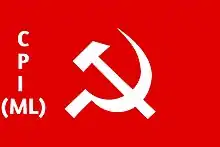Bhojpur Uprising
Bhojpur uprising was an armed Naxalites peasant revolt in 1975 in the Bhojpur block of the Bhojpur District in Bihar, India. It was mainly led by Subrata Dutta, second general secretary of CPIML Party.[1] The armed struggle became an inspiration to the naxalite movement which rapidly spread in all over North India including Bihar & Todays Jharkhand.[2]
| Bhojpur Uprising | |||
|---|---|---|---|
| Part of Cold War and Naxalite Insurgency | |||
 | |||
| |||
| Belligerents | |||
|
Supported by: |
Supported by: | ||
| Commanders and leaders | |||
|
|
| ||
| Units involved | |||
|
Bihar Police CRPF |
| ||
| Casualties and losses | |||
|
227 Police Personnel killed 142 CRPF Personnel killed |
96 Naxalites killed 117 Villagers killed | ||
Origin
In 1973, the original Communist Party of India (Marxist–Leninist) split, with one group led by Sharma and another by Mahadev Mukherjee. Vinod Mishra initially belonged to Mukherjee's party, but he and the Burdwan Regional Committee broke with Mukherjee in September 1973. Mishra sought contact with the Sharma group, but the Burdwan Regional Committee was later divided and Mishra denounced the political line of Sharma (a critique, which amongst other things, called for the formation of open mass organizations, a move that almost constituted a heresy in the CPIML ).[3]
In 1974, Mishra came into contact with Subrata Dutta (Jauhar), a leader of armed struggle in the plain areas of Bihar. On 28 July 1974 (the second death anniversary of Charu Majumdar) a new party Central Committee was formed with Subrata Dutta as General Secretary, Vinod Mishra and Swadesh Bhattacharya as founder party members.[4] The reorganized party became known as the 'anti-Lin Biao' group became known as CPIML Liberation.[5]
After the promotion as general secretary, Subrata Dutta launch Bhojpur Peasants Movement.[4][6][7]
Decline
By 1974, activities of the Lal Sena increased along with there increasing actions. The government sent 4,000 police and 800 CRPF to tackle the uprising. By January 1975, 120 CRPF were killed. But the uprising soon met a rapid decline. The major cause of decline the uprising because death of leading figures of the movement like Subrata Dutta, Doctor Nirmal and Satyendra Yadav.[2][8][9]
References
- "Com. Subrata Dutta (Jouhar)". Cpiml.org. Retrieved 4 February 2022.
- Partha Sarathi Kar. "West Bengal once again threatened with Naxalite resurgence". India Today. Retrieved 4 February 2022.
- "A Lesson In Dynamism And Dedication". Archived from the original on 23 September 2015. Retrieved 4 February 2022.
- "The Bhojpur Revolutionaries Fought For Freedom, Equality, Justice And Unity | Communist Party of India (Marxist-Leninist) Liberation". Cpiml.net. Retrieved 4 February 2022.
- VENKITESH RAMAKRISHNAN. "The road from Naxalbari". Archived from the original on 17 October 2006. Retrieved 4 February 2022.
- "Peasant Revolt in Bhojpur". Economic and Political Weekly. 14 (36): 7–8. 5 June 2015. Retrieved 4 February 2022.
- Satish Kumar. "Declining Naxalism from Central Bihar" (PDF). Police.bihar.gov.in. Retrieved 4 February 2022.
- "Free radical". Himalmag.com. 31 January 1999. Retrieved 4 February 2022.